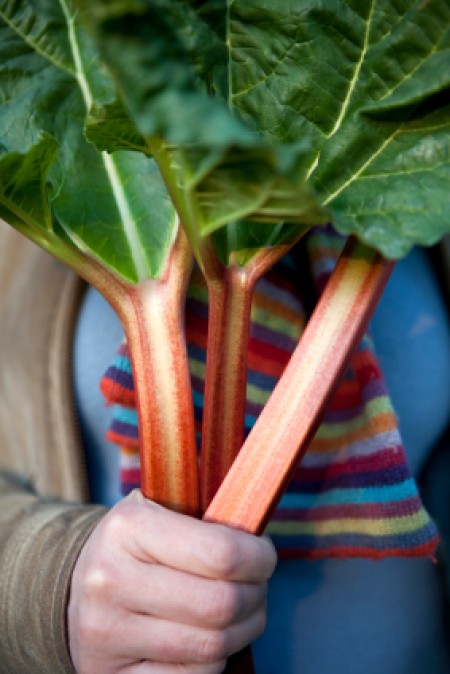
If you enjoy cooking with rhubarb, it's worth making space for a few of these plants in your garden. Although the tart flavored stalks are traditionally used like a fruit for pies, jams, and jellies, rhubarb is actually a long-lived perennial vegetable. With just a minimal amount of effort and care, an established plant will happily provide you with a crop of tasty stalks and attractive foliage for many years.
Rhubarb is classified as a cold-resistant perennial vegetable. It grows best in climates where the ground freezes to a depth of several inches in the winter, and where summer temperatures seldom climb above 90 degrees F. Although rhubarb is eaten and enjoyed throughout the United States, it tends to struggle in hot, dry climates and can be difficult to grow in many parts of the south (commercial production is concentrated in Washington, Oregon, and Michigan).
Propagation: Rhubarb is usually propagated by planting "crowns" (divisions of the roots that contain buds for new plants). If you neighbor doesn't have some extra plants to share, crowns are easy to obtain at nurseries, garden centers, or through mail order (or online) catalogs. Two to three plants will usually provide plenty of stalks for the needs of an average family.
Where to plant: If you take the time to prepare your planting site ahead of time, established plants will reward you handsomely for possibly decades into the future. Because rhubarb is a long-lived perennial, it's best to set aside a large, sunny, out-of-the-way spot in the garden where it will be free to grow without interfering with annual vegetable crops. Rhubarb is a heavy feeder and grows best when planted in fertile, well-drained soil with a pH of 6.0-6.8. Work the soil to a depth of 24 inches before setting in the crowns so roots have plenty of room to expand.
How to plant: Plant rhubarb in early spring. For each crown, dig a hole 2 feet deep and 2 feet wide. Space each hole 3 feet apart in all directions. (Some varieties are larger and may need even more space). Back-fill the hole to a depth of 12 inches with equal part soil and compost or well-rotted manure, plus 1/3 cup of 10-10-10- fertilizer.
Place one crown in each hole so that the plant buds sit 3-4 inches below the soil surface. Tamp the soil firmly around the roots, and fill the remainder of the hole with equal parts compost and topsoil. Mulch around each plant to conserve moisture and protect roots.
Feeding: Work a balanced (10-10-10) fertilizer into the top few inches of soil around the shoots at the first sign of growth each spring.
Division: Older plants can become crowded and should be divided every 4 to 5 years or when they start to exhibit spindly growth. This is best done in the early spring. Use a sharp spade to cut down through the center of the plant. Cut the roots of the removed portion into several parts, each of which should have one to three buds. Plant them as you would crowns.
Harvesting: Rhubarb plants are usually mature enough for harvesting a few stalks the second year after planting. Stalks are ready to pull when they are 12 to 18 inches long. Young stalks with the deepest red color usually have the best flavor, although some varieties produce only green-colored stalks. Harvest the stalks by twisting them off near the base (cut stems bleed and encourage disease). Rhubarb leaves should never be harvested for food as they contain high amounts of oxalic acid, which can be poisonous.
To maximize production, remove seed spikes as soon as they form to keep them from diverting nutrients from the stalks. Stop harvesting in early July to give plants time to build up food stores for next season.

About The Author: Ellen Brown is an environmental writer and photographer and the owner of Sustainable Media, an environmental media company that specializes in helping businesses and organizations promote eco-friendly products and services.
Add your voice! Click below to comment. ThriftyFun is powered by your wisdom!